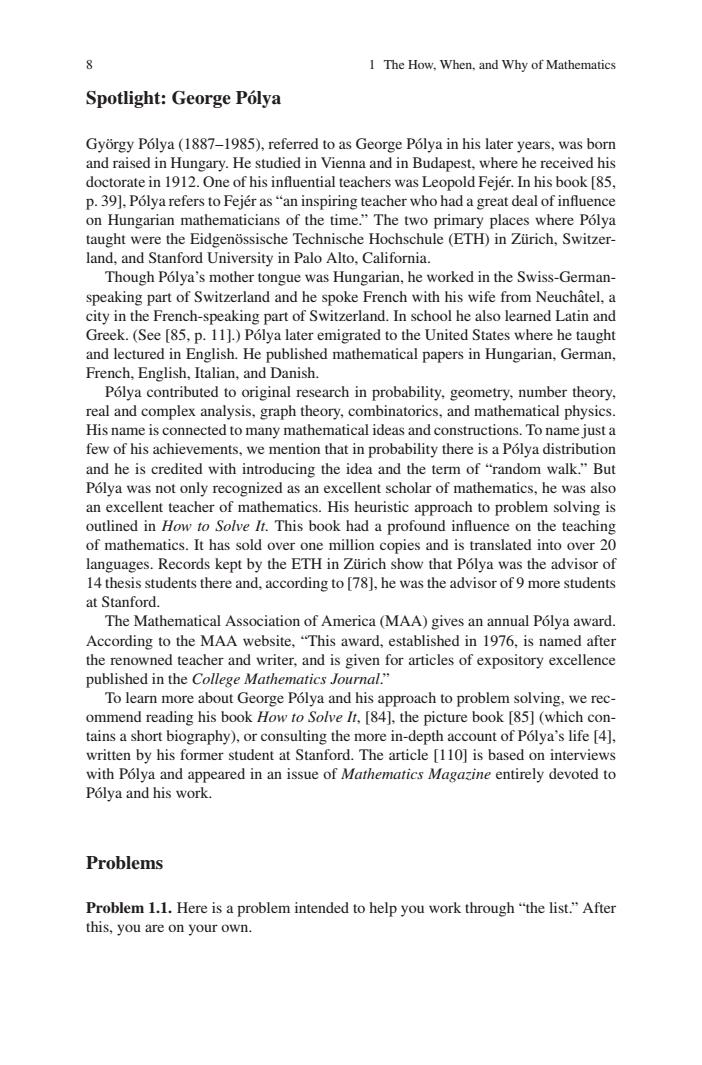正在加载图片...

8 I The How,When,and Why of Mathematics Spotlight:George Polya Gyorgy Polya(1887-1985),referred to as George Polya in his later years,was born and raised in Hungary.He studied in Vienna and in Budapest,where he received his doctorate in 1912.One of his influential teachers was Leopold Fejer.In his book [85, p.39].Polya refers to Fejer as"an inspiring teacher who had a great deal of influence on Hungarian mathematicians of the time."The two primary places where Polya taught were the Eidgenossische Technische Hochschule(ETH)in Zurich,Switzer- land,and Stanford University in Palo Alto,California. Though Polya's mother tongue was Hungarian,he worked in the Swiss-German- speaking part of Switzerland and he spoke French with his wife from Neuchatel,a city in the French-speaking part of Switzerland.In school he also learned Latin and Greek.(See [85,p.11].)Polya later emigrated to the United States where he taught and lectured in English.He published mathematical papers in Hungarian,German, French,English,Italian,and Danish. Polya contributed to original research in probability,geometry,number theory, real and complex analysis,graph theory,combinatorics,and mathematical physics. His name is connected to many mathematical ideas and constructions.To name just a few of his achievements,we mention that in probability there is a Polya distribution and he is credited with introducing the idea and the term of"random walk."But Polya was not only recognized as an excellent scholar of mathematics,he was also an excellent teacher of mathematics.His heuristic approach to problem solving is outlined in How to Solve It.This book had a profound influence on the teaching of mathematics.It has sold over one million copies and is translated into over 20 languages.Records kept by the ETH in Zuirich show that Polya was the advisor of 14 thesis students there and,according to [78],he was the advisor of 9 more students at Stanford. The Mathematical Association of America(MAA)gives an annual Polya award. According to the MAA website,"This award,established in 1976,is named after the renowned teacher and writer,and is given for articles of expository excellence published in the College Mathematics Journal." To learn more about George Polya and his approach to problem solving,we rec- ommend reading his book How to Solve It,[84],the picture book [85](which con- tains a short biography),or consulting the more in-depth account of Polya's life [4], written by his former student at Stanford.The article [110]is based on interviews with Polya and appeared in an issue of Mathematics Magazine entirely devoted to Polya and his work. Problems Problem 1.1.Here is a problem intended to help you work through"the list."After this,you are on your own.8 1 The How, When, and Why of Mathematics Spotlight: George Polya ´ Gyorgy P ¨ olya (1887–1985), referred to as George P ´ olya in his later years, was born ´ and raised in Hungary. He studied in Vienna and in Budapest, where he received his doctorate in 1912. One of his influential teachers was Leopold Fejer. In his book [85, ´ p. 39], Polya refers to Fej ´ er as “an inspiring teacher who had a great deal of influence ´ on Hungarian mathematicians of the time.” The two primary places where Polya ´ taught were the Eidgenossische Technische Hochschule (ETH) in Z ¨ urich, Switzer- ¨ land, and Stanford University in Palo Alto, California. Though Polya’s mother tongue was Hungarian, he worked in the Swiss-German- ´ speaking part of Switzerland and he spoke French with his wife from Neuchatel, a ˆ city in the French-speaking part of Switzerland. In school he also learned Latin and Greek. (See [85, p. 11].) Polya later emigrated to the United States where he taught ´ and lectured in English. He published mathematical papers in Hungarian, German, French, English, Italian, and Danish. Polya contributed to original research in probability, geometry, number theory, ´ real and complex analysis, graph theory, combinatorics, and mathematical physics. His name is connected to many mathematical ideas and constructions. To name just a few of his achievements, we mention that in probability there is a Polya distribution ´ and he is credited with introducing the idea and the term of “random walk.” But Polya was not only recognized as an excellent scholar of mathematics, he was also ´ an excellent teacher of mathematics. His heuristic approach to problem solving is outlined in How to Solve It. This book had a profound influence on the teaching of mathematics. It has sold over one million copies and is translated into over 20 languages. Records kept by the ETH in Zurich show that P ¨ olya was the advisor of ´ 14 thesis students there and, according to [78], he was the advisor of 9 more students at Stanford. The Mathematical Association of America (MAA) gives an annual Polya award. ´ According to the MAA website, “This award, established in 1976, is named after the renowned teacher and writer, and is given for articles of expository excellence published in the College Mathematics Journal.” To learn more about George Polya and his approach to problem solving, we rec- ´ ommend reading his book How to Solve It, [84], the picture book [85] (which contains a short biography), or consulting the more in-depth account of Polya’s life [4], ´ written by his former student at Stanford. The article [110] is based on interviews with Polya and appeared in an issue of ´ Mathematics Magazine entirely devoted to Polya and his work. ´ Problems Problem 1.1. Here is a problem intended to help you work through “the list.” After this, you are on your own